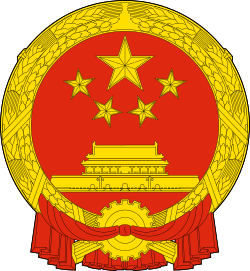China Democratic League
China Democratic League 中国民主同盟 | |
|---|---|
| Chairperson | Zhang Baowen |
| Founded | 19 March 1941 |
| Headquarters | Beijing |
| Membership | 230,000 |
| Ideology |
Socialism with Chinese characteristics Social democracy |
| Website | |
| Official Site | |
| China Democratic League | |||||||
| Traditional Chinese | 中國民主同盟 | ||||||
|---|---|---|---|---|---|---|---|
| Simplified Chinese | 中国民主同盟 | ||||||
| |||||||
The China Democratic League (Chinese: 中国民主同盟, often abbreviated to 民盟) is one of the eight legally recognised political parties in the People's Republic of China.
The party was established in 1941 and took its present name in 1944. At its formation, it was a coalition of three pro-democracy parties and three pressure groups. Its two main goals were to support China's war effort during the Second Sino-Japanese War and to provide a "Third Way" from the Nationalists and the Communists. Influential members or supporters included Liang Shuming, Fei Xiaotong, Li Huang of the Young China Party, Zhang Junmai (Carson Chang), Huang Yanpei, Wu Han, Chu Anping, and Wen Yiduo.[1]
After the war, many Americans in China were sympathetic. Theodore White wrote that if "the men of the middle group were well organized, they could guarantee peace. But they are not. They lack an army, a political machine, roots in any social class. Only the spread of education and industry can create enough men of the modern world to give them a broad social base.” [2] But disillusionment with the Nationalist government, which outlawed the party in 1947, and infiltration by the Communists caused the League to tilt towards the CCP during the Chinese Civil War. Thereafter, two of its constituent parties, the China National Socialist Party and the Chinese Youth Party, left the League to join the Nationalists in Taiwan. The "Third Party" eventually became the Chinese Peasants' and Workers' Democratic Party in 1947. It left the League, but remained pro-Communist.
The three interest groups were the National Salvation Association, the Rural Reconstruction Association, and the Vocational Education Society. The NSA, by far the largest and most popular of the interest groups, was inspired by the National Salvation Armies and existed to encourage resistance against Japan, but became irrelevant after the war's end. The RRA was an agrarianist lobby formed from the Rural Reconstruction Movement, which was originally hostile to communism but their interests in peasant welfare gradually intersected. The third interest group, the Vocational Education Society, wanted to establish vocational schools throughout China and became the core of the China Democratic National Construction Association.
In 1997, it adopted a constitution, which stipulated that its program was "to hold high the banner of patriotism and socialism, implement the basic line for the primary stage of socialism, safeguard stability in the society, strengthen services to national unity and strive for the promotion of socialist modernisation, establishment and improvement of a market economy, enhancement of political restructuring and socialist spiritual civilisation, emancipation and development of productive forces, consolidation and expansion of the united patriotic front and realisation of the grand goals of socialism with Chinese characteristics."
The League is mainly made up by middle-level and senior intellectuals in the fields of culture, education, science and technology. As of the end of 2012, the party had a membership of more than 230,000. Of this total, 56.6% were from the field of compulsory education, 17.7% were in science and technology.[3]
Chairpersons
- Huang Yanpei (黄炎培): 1941—1941
- Zhang Lan (张澜): 1941—1955
- Shen Junru (沈钧儒): 1955—1963
- Yang Mingxuan (杨明轩): 1963—1967
- Shi Liang (史良): 1979—1985
- Hu Yuzhi (胡愈之): acting, 1985—1986
- Chu Tunan (楚图南): 1986—1987
- Fei Xiaotong (费孝通): 1987—1996
- Ding Shisun (丁石孙): 1996—2005
- Jiang Shusheng (蒋树声) 2005—2012
- Zhang Baowen (张宝文) 2012— incumbent
References
- ↑ Roads Not Taken: The Struggle of Opposition Parties in Twentieth Century China, Edited by Roger B. Jeans. Boulder, Colorado: Westview Press, 1992.
- ↑ Theodore H. White and Annalee Jacoby, Thunder Out of China (NY: William Sloane Associates, Inc. 1946): 313.
- ↑ 中国民主同盟简介 (in Chinese). China Democratic League. Retrieved September 13, 2011.
